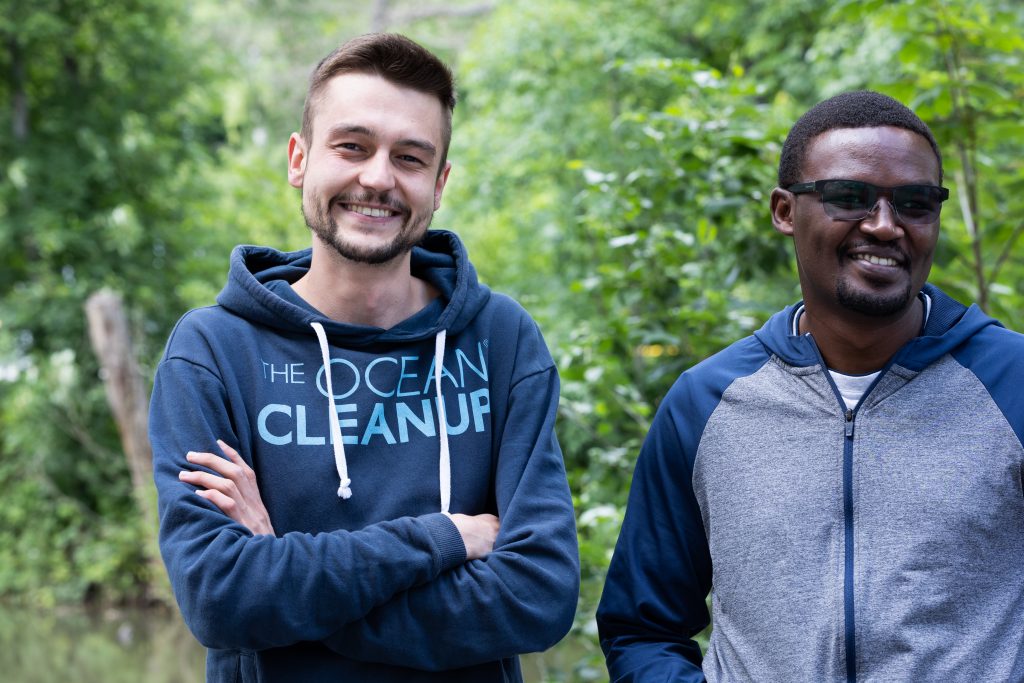Before diving into how we turn parcel machines into ecosystems, we would like to start off with a quote.
A wise wizard once told the creatives from Smartmile:
“We are only as strong as we are united and as weak as we are divided.”
– Albus Dumbledore
(Yep, some of our members quote him daily)
Even though these are words by a fictional character with no concrete standing in the last mile, they hold a wicked truth.
The last mile includes several stakeholders worldwide: multiple courier companies, locker networks, local retailers, online stores, and billions of e-shoppers. They all make choices that affect the last mile and its footprint, inefficiency and costs. But don’t worry; all stakeholders also hold a part of the solution.
At Smartmile, we share one core belief: because so many stakeholders are involved in the last mile, we can only change it by getting every stakeholder to connect in a shared solution.
Our founders: Aku, master of the parcel lockers, and Steffen, king of software, combined their strengths, found a team, and set out to build the first neutral basis for the last mile. Turning parcel machines into ecosystems with software to integrate any last mile stakeholder worldwide and make it easy for them to collaborate.
How did we create this core technology? What makes it such a tricky business? And what will we do next?
Step 1: The magic of turning any parcel machines into ecosystems— our hardware-independent software platform.
At the core, we are sustainable and made this mindset part of our solution design. When we developed our software, we wanted to ensure we could work with local machine suppliers across the globe, sourcing our hardware with minimal footprint while overcoming supply chain challenges.
Our team created an "abstraction layer" that takes the essential software running on any parcel machine, all machine software setups being inherently different, and abstract it to run our software without any problem.
This means we can run our full technology on any machine provider and all their machine types, from small indoor (wooden) lockers to huge, fully automated robotic devices.
Little did we know, there are even more upsides to hardware independence. Imagine expanding by 100 machines in two months; finding a supplier with the same amount of machine stock readily available can take time. This level of agility, however, was a must for us. By working with any machine supplier, we get to minimize dependency on single players and find the best machines or combinations of machines to get the job done.
There is a third advantage to hardware independence laying at the heart of our customer experience. We mix and match machine types across our ecosystems, but by launching the same system on all of them, we create the same user experience and integrations anywhere. If any parcel machine worldwide had the same user interface and easy experience, customers would only have to get used to one way of navigating parcel machines instead of making customers deal with numerous different ways of operating.
More recently, we have been exploring the potential in being able to run our software on existing networks.
With hardware independence, how any network worldwide is built up becomes almost irrelevant. We can abstract the hardware and run our software easily.
Welcoming new providers to our machine portfolio takes approximately a day, depending on the readiness of the partner technology and documentation. So far, we have integrated eleven manufacturers and fifteen different machine models.
Step 2: Chameleon powers activate to integrate any courier, retailer, or impact partner. We all have great solutions to combine.
To turn parcel machines into ecosystems with connected stakeholders getting a hold of the footprint and flows across the industry, our lockers must be able to connect any system—the core challenge in solving the last mile. Any courier system, e-commerce setup, or retail system is different because there are a million roads leading to the Rome we call software development.
We, as creatives, like to describe our system as a magical chameleon or a superhero translator able to understand any accent, language, or slang you throw at it and communicate back with ready-made, multi-language responses. We talked it over with Fabian, and this creative description is close to the truth.
Our system can abstract partner systems and distill the required information set to create a flexible communications bridge. Because of the abstraction, it does not matter which system or language any partner tools run. By being this flexible in understanding and communicating, any collaboration or function between our’s and our partner’s systems is possible.
We are pretty thrilled we get to keep our magical chameleon metaphor and even more thrilled to find out that this chameleon cannot only talk to any system, but Fabian and the team also equipped it with a special toolbelt. This toolbelt comprises a template language and a low- to no-code development flow. In short, building integrations for our team is almost as easy as playing Tetris.
To build a new integration, we first meet with our partners, discuss how to exchange data best, establish system communication, and determine the user flows and functionalities to offer. We simply have to configure templated actions, events and triggers through this toolbelt. After that, we roll out a pilot on a set of hubs or a smaller area. Once the pilot runs smoothly, we push it nationally or internationally.
Because of the Smartmile system, creativity is limitless; our partner ecosystem can design any service just like a chameleon, changing to any necessary colour pattern to fit into its environment.
Step 3: How we make designing new services easy.
Building new services can be a part of integrations, so we made it easy and low-code. We can add new service flows to any of our integrations. Communication between systems is already established, and our templated low- to no-code approach makes creative service design barrier-free.
It is, again, only a matter of configuring the right pre-templated actions, triggers, and events. For example, couriers loading parcels, customers picking up, scanning return labels, or logging in using QR codes.
But we can also realize more innovative services through our parcel lockers, such as opening compartments for collecting donations, exchanging products directly between a local retailer and a customer, returning reusable packaging, building a locker-based marketplace, and more.
Any of these types of services comes down to a configuration, and all required parts are templates available in the toolbelt of our chameleon. By making development this easy, we lower the barrier of expansion and competition for smaller market participants. Smaller players can innovate based on our existing ecosystem which could be the starting point for their scaling to national or international success without having to pre-invest in the whole infrastructure. So in a way, we minimize development time by mostly configuring to change the world.
Step 4: How the Smartmile ecosystem connects the last mile and prepares it for the EU-wide Corporate Sustainability Reporting Directive (CSRD).
The last mile, as it is, is the most costly and high-emission part of delivery and e-commerce. We establish a direct connection between last-mile stakeholders and invite them to collaborate. Design new services as one system, which will be a lot more effective at changing the industry as a whole; a direct first step to report on. Our network allows partners to impact the footprint of the last mile and to serve communities surrounding the machines.
Today is not the time to continue siloed thinking but to introduce platform thinking in e-commerce and delivery. That is why we have the technology to realize a delivery ecosystem where any partner process can allign with other stakeholders. We can get a hold of the industry and make the process enjoyable and efficient.
– Smartmile Founders
We designed our tools and system with the lowest possible technological barrier to ensure partners can create new services and re-think their processes regardless of size. Experimenting and developing new services together does not require huge budgets, lots of time or extensive technological knowledge with Smartmile at the core.
Our ability to lower development barriers spans different complexity levels, from the simple web-form-based integration to the large-scale national use case with e-commerce, SAP, warehouse automation and automated fulfillment integration for devices with serial number tracking capabilities. We have already built these types of setups and made them accessible.
Our system makes building new ways of running last-mile processes easy to implement. This ease of design also means we can offer connected partners a platform to collaborate and, most importantly, experiment.
Not one of us knows what exactly has to change to make the last mile footprint-free but to get closer to understanding this and reporting on the progress; we have to be able to experiment and collaborate risk-free—implementing platform thinking and knowledge sharing at the core of changing the last mile. Imagine if we would connect the world through Smartmile technology and put all of our brilliant ideas together in one ecosystem.
What a magical world that would be.
Step 5: How can we turn parcel machines into ecosystems securely across the globe.
We are nearing the end of our deep dive into the magical world of Smartmile technology. As one beautiful end note, we wanted to shine some light on how we manage to turn parcel machines into ecosystems worldwide because, you guessed it, we planned for scaling from the start. To quote our wizard Fabian:
“We developed the Smartmile technology with scalability as a core pillar from day one,”
– Fabian Head of R&D at Smartmile
meaning that from our architecture through to how we expand our functionalities, we developed all to scale. On top of that, we are in the process of getting our ISO-27001 certification to ensure our systems adhere to the highest security standards.
Step 6: What is next for Smartmile?
We hope you had a great journey through the magical world of our technology. New spells are constantly in the works to push the boundaries of our Hubs further. To prove it, we already have four Patents pending combining machine functionality, user verification, capacity optimization, repurposing returns and more. All from that same magical set of minds: our Tech herd.
Writing this piece, we uncovered that while technology can feel like novel-inspired magic, it is actually magic that exists in the real world. Our technology is a concrete and powerful part of our company and essential in changing the last mile.
For now, we part ways, but stay tuned to learn more, and check out our LinkedIn for the upcoming in-depth interviews with Fabian! We sure are excited to share them with you. For more post, head back to our Blog.




